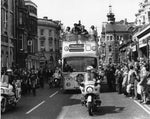Barbour of South Shields are close to the heart of Pickings and Parry. The family origins of our store hail from the same North Eastern area of South Tyneside, England, where the Barbour clothing company was founded in 1894 and, growing up in the 1980's, it was hard to walk a mile without passing someone wearing a Barbour Jacket.
Now a fifth generation family business, Barbour still operates from it's factory and HQ in South Shields and most of the Country and Core Range jackets are still made in this UK manufacturing facility. So what brought about this popularity, and why South Shields? The history is a long one at 122 years, so we'll stick to the highlights, of which there are many....

The origins of Waxed Cotton fabric lie, not surprisingly, within the shipping industry. Sailors would coat flax sails with fish oils and grease to improve their performance and the old and damaged sails would be converted into hats and capes to protect the mariners at sea. By 1795 flax sail cloth was being manufactured commercially and, shortly after, experiments were carried out with a the newly available and lighter weight cotton yarn.
Fast forward 90 years or so and we find John Barbour, a Scotsman living in the sea faring port town of South Shields. John recognised a need for waterproof, comfortable and hard wearing clothing amongst the working families of Northern England and, thus, Barbour was born.

Arguably the first company in the world to adopt the revolutionary waxed cotton fabric for commercial clothing use, Barbour was clearly onto a winner, and it wasn't long before the small enterprise became a successful family business. In 1908 John's son Malcolm produced the first Barbour mail order catalogues and, by 1917, catalogue sales accounted for 75% of Barbour's sales with orders from as far away as Chile, South Africa and Hong Kong.
By 1912 Barbour was well established and, with both of his sons now in the business, the company became J Barbour & Sons Ltd, the name by which it is still officially known.
In 1928 the next generation of the Barbour family joined the team, with the appointment of Malcolm's son Duncan to the company. As a keen motorcyclist, Duncan Barbour saw the potential for waxed cotton clothing as all weather motorcycling apparel. The affordable and exciting mode of transport was ever growing in popularity during the 1930's and this segment of the business took off quickly. In 1936 the famous Barbour One Piece riding suit was designed and became an essential piece of gear for any serious daily rider.
Unfortunately, by the late 1930's, the looming threat of war in Europe began to have an impact on daily life across Great Britain and, as war was declared in 1939, the future was uncertain for Barbour...

....But, as the war effort grew, so to did the demand for protective military clothing, which turned out to be in important development in the story of Barbour clothing. Impressed by the weather protection of the Barbour one piece motorcycling suit, Submarine Commander Captain George Philips commissioned a two piece version for his crew on the HMS Ursula. This outfit became standard issue for submariners throughout WWII and would go on to inspire another milestone piece of motorcycling gear in the future!

As the One Piece Motorcycling Suit had inspired the Ursula, the Ursula Jacket inspired one of Barbour's most famous and internationally recognisable garments, the International Trials Jacket. First released in 1951 using the classic olive green Barbour thornproof waxed fabric, it featured two rear pockets and a diagonal chest pocket to accommodate trials cards and maps.
The jacket was instantly popular and virtually every British team wore Barbour for the next 40 years. It was redesigned following a collaboration with the Vincent owners club in 1953, when it was released in black waxed cotton with brass snap buttons to mimic the colouring of the Vincent motorcycle paintwork.
The Jacket became so popular that by the time of the 1957 International 6 Day Trials event, 97% of riders wore Barbour. Famously, whilst in transit to the 1964 ISDT event, Steve McQueen and the USA team made a scheduled stop off in London to pick up their team jackets emblazoned with the Stars and Stripes flag; the images of this event have become famous in themselves and Barbour launched their first Steve McQueen collection in 2011 as a tribute to impact of this race and it's film star competitor.

The late 1960's saw another abrupt change to company structure, following the premature and tragic death of John Barbour, Grandson of the founder. Control was passed to his 28 year old widow, Margaret, and the subsequent decades saw Barbour develop from the practical weather protection brand it was, into the global lifestyle brand it is today.
A certain prestigious family's love for the brand no doubt played a part in the global growth of Barbour during this period. In 1974, the first Royal warrant was awarded to Barbour by Prince Philip, followed in 1982 by a second from HM the Queen and again by a third from Prince Charles in 1987. The royal warrants and association as the chosen outerwear of Royalty led to incredibly strong sales throughout the 1980's and Barbour became a household name.

The 1990's were rather uneventful for the company, compared to the explosion of the 80's, but the mid 2000's once again saw Barbour popularity take off as British music stars and celebrities chose Barbour as their jacket of choice for festivals such as Glastonbury and Reading. Once again it became hard to walk down a street in London without seeing someone wearing a Barbour Waxed Jacket.
The growing appreciation for heritage brands over the last decade has seen the company solidify it's global reputation as one of quality and history. This position was highlighted in 2011 when Barbour began releasing collections purely for the Japanese market, collaborating with Japanese designers such as Tokito to create limited edition pieces....

...One of these designs was picked up by none other than James Bond in the 2012 movie Skyfall and has since been reissued, by popular demand, as the Barbour Beacon Sports Heritage Jacket.
Since it's inception, Barbour has been about quality and practicality. They have remained local, yet now have an extensive collection and global reach as a lifestyle brand. For us, they are a proud product of our Northern English origins and hold a place in British history that few other brands could ever hope for.
Stay dry, stay warm.


